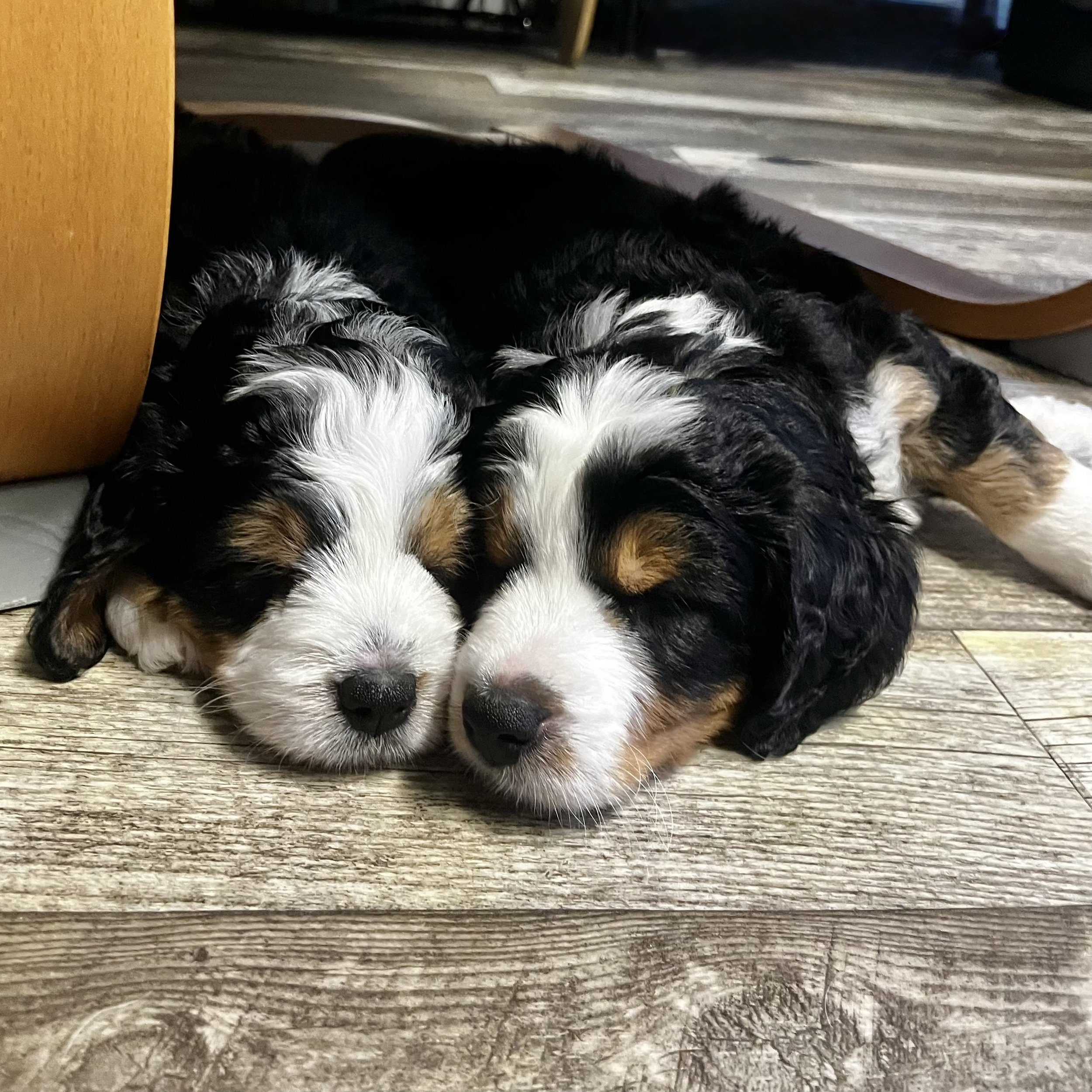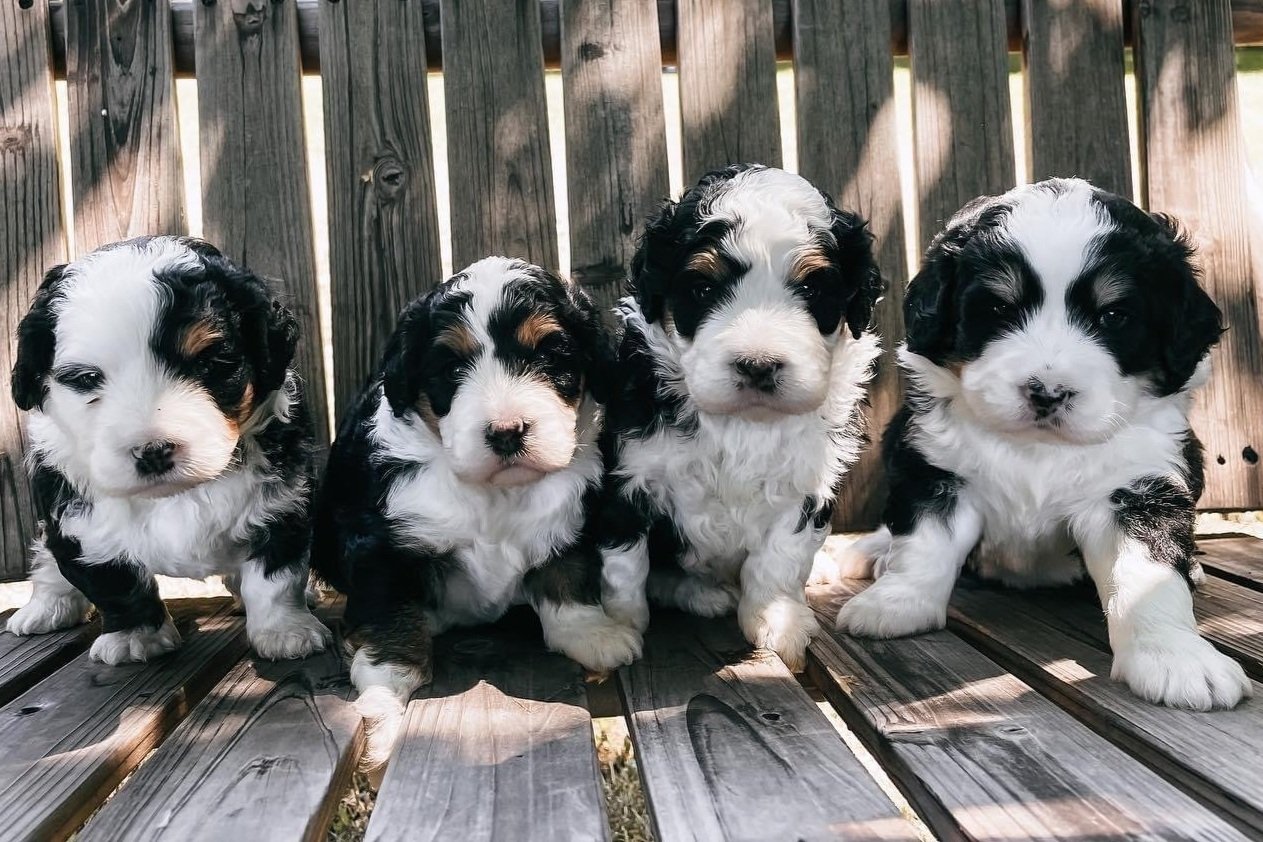
Bernedoodles 101
What is a Bernedoodle?
The Bernedoodle is an intentional breeding between a Bernese Mountain Dog and a Poodle. This hybrid combines the intelligent, low shedding, playfulness of a poodle and the chill, loyal temperament of a Bernese Mountain dog. While most doodles are known for being energetic and super active, a Bernedoodle has a more laid back personality with a medium activity level. Bernedoodles are up for hiking, walks, dog parks and adventures, but they are also content to snuggle with their people and take a nap.
The internet offers loads of information on Bernedoodles. My goal with this page is to gather some of that information for you so that you can learn more about this amazing breed to decide if a Bernedoodle is right for your family. Swiss Ridge Kennels in Ontario, Canada is credited with being the first kennel to intentionally breed a Bernedoodle and their website and book can offer prospective Bernedoodle parents a wealth of information.
THE FACTS
Bernedoodle Personality & Temperament
Bernedoodles seem to get many of the best personality traits from the Bernese Mountain Dog and Poodle breeds. They are great family dogs that are gentle, friendly, outgoing, and playful. Each dog is an individual so personalities of dogs within the breed vary. Bernedoodles tend to be highly intelligent, hardworking when necessary, loyal, and just a bit goofy. They are good with children and other dogs, provided they have been well socialized.
Positive socialization experiences are SUPER important for Bernedoodles! Exposing them to as many people and places as possible, especially at a young age will prevent them from becoming anxious and apprehensive around strangers. Some dogs may inherit the Bernese Mountain Dog's stubbornness, which may make them difficult to train, however this trait tends to fade away as puppies become adolescent dogs. Fortunately, when they begin training, Bernedoodle’s intelligence helps them pick up commands more easily than other dogs.
Bernedoodles crave attention and at least moderate exercise. They do best in homes where they are not left alone for long periods of time. Generally, they want nothing more than to be with their humans and are just as ready to go outside and play with them as they are to join them on the couch for cuddles.
Bernedoodle Sizes
Bernedoodles can come in three different sizes determined from the Poodle used for breeding:
Standard Bernedoodles: The Standard Bernedoodles are the most common and ranges from 18 inches tall up to 29 inches tall while weighing 65+ pounds. They are similar to the size of a small Bernese Mountain Dog. These dogs have a standard size mom and dad.
Small Standard/ Large Mini: There is some overlap here so we use two different size categories for these bernedoodles. Bernedoodles are 12 to 18 inches tall, while the weight can range from 40-65 pounds. This is our most common size.
Mini: Mini Bernedoodles are smaller and range from 25-45 pounds. A Mini Bernedoodle is from breeding a Miniature Poodle with a Bernese Mountain Dog or Bernedoodle.
Micro Bernedoodles: The Tiny Bernedoodle is probably the smallest variant of the Bernedoodle can you can ever get. It can reach 8 to 10 inches tall while weighing less than 15 pounds. These Bernedoodles tend to be more hyper because they are part toy poodle. VidaDoodle does not breed tiny Bernedoodles.
Bernedoodle Health
Like most mix breed dogs, Bernedoodles are generally healthy dogs. There are, however, some conditions that Bernedoodles may be predisposed to including hip dysplasia, elbow dysplasia, eye problems, and skin issues such as allergies and hot spots. All breeds may be affected by any number of health concerns, but the Bernedoodle is generally a healthy breed.
You can avoid health issues by taking your dog to the vet regularly, making sure they get lots of exercise and feeding them a high-quality diet.
Bernedoodle Generations
F1 Bernedoodle Puppies
1. F1 puppies are 50% Bernese Mountain Dog / 50% Poodle and can be born from either a Berner Mom or a poodle mom with the father being the other breed.
2. F1 litters have wavy, non-shedding coats. These litters are more consistent in the colors and patterns with slight variations in markings. Ie; the white blaze between the eyes may be thicker on some and thinner on others but they all look similar.
3. F1 litters have a slightly higher chance of shedding, although in my experience F1 puppies are likely to be mostly hypoallergenic so this isn’t a big factor. However, if your family has allergies, this generation may not be the best choice.
F1b Bernedoodle Puppies
1. F1b puppies are born from a Bernedoodle Mom with the father being a Poodle.
2. F1b tend to be the most hypoallergenic and usually have curlier coats because they are 75% poodle and 25% Berner.
3. These litters tend to have more variation in color depending on the poodle so you can see phantoms, sables, traditional tricolored, parti tricolored and Sable tricolored, bicolored including apricot/white, black/white or brown/white and solid colored depending on what the poodle parent looks like.
Multigeneration (F2b) Puppies
1. Mom is an F2 bernedoodle and dad is a poodle.
2. There’s more variation in the coat colors because there were 2 poodle dad’s involved in the making of the Bernedoodle parents. One for the mom and one for the dad. Like F1b puppies, you could see phantoms, sables, traditional tricolored, parti tricolored and Sable tricolored, bicolored including apricot/white, black/white or brown/white and solid colored depending on what the Bernedoodle parents look like. If both Bernedoodle parents are genetically tri colored, then some of their pups will be too!
3. They are generally non shedding, which means that their wavy to curly, non-shedding coats make F2b puppies an awesome choice for people with allergies.
Bernedoodle Activity Level
Bernedoodles have medium energy levels and require daily exercise! They'll need at least a nice, long daily walk to burn off energy. Due to the Bernedoodle’s intelligence, in addition to exercise, they need mental stimulation which can include things like training, games, and puzzles,
Bernedoodle’s enjoy some variation to daily activities. You can try hiking (if you live near such terrain), playing in the dog park, training sessions or even opting for some water activities if you live near water bodies! No matter what activities you choose, it will help to keep your dog fit and, at the same time, help to develop a stronger bond between you and the Bernedoodle. Keep in mind that for their safety and joint health, bernedoodles should not take long walks (over a mile or so), hikes (steep or with rocky terrain) or be allowed to jump from beds or furniture until they are over a year.
Bernedoodle Coat
Bernedoodle coats can vary but usually they have wavy, curly coats that don't shed much, which can help make them more suitable for people with allergies to dander.
The curlier the Bernedoodle's coat is the more likely it is to be hypoallergenic. However, because they shed less, they need to be brushed more often to prevent their coat from getting matted. Some Bernedoodle owners brush their dog's coat daily and treat it as a bonding experience, which this breed tends to love. Their coat must also be trimmed every few months, depending on how quickly it grows. (see grooming)
Bernedoodle Grooming
Like all Poodle mix dogs, Bernedoodles require lots of brushing and grooming. You should plan to budget for regular visits to the groomer unless you feel confident with clippers and scissors.
A low shedding coat requires maintenance. Each day you will need to spend some time brushing and grooming your Bernedoodle. If you do not brush your Bernedoodle, they will get painful knots and mats, and it will increase your grooming expenses. The plus side is that spending a little time every day brushing your dog is a great bonding experience.
How often do Bernedoodle’s need to be groomed? You should plan to do this every 6-8 weeks, depending on your tolerance of the dog’s coat’s length.
Bernedoodles as Therapy Dogs
Bernedoodles are intelligent and make a strong bond with their owners. This combination makes Bernedoodles great dogs to be trained for owners with autism, emotional support needs, diabetes, life-threatening allergies, hearing impairment, and visual impairment. They are not only obedient and loyal but are also eager to please their owners. If properly socialized, when Bernedoodles are touched or petted on any part of the body, they are comfortable. which is an important feature in a therapy or service dog. They almost shed no hair or dander and are an ideal breed for those patients who are allergic to dog dander and hair.
Although the Bernedoodles come in 3 different sizes, most Bernedoodles are on the bigger side so they are not an ideal match for a person with mobility impairment or balance disorders. Also, Bernedoodles are medium to high-energy dogs and they must be exercised regularly which may be difficult to manage for certain disabilities.
By nature, Bernedoodles are friendly, loving, social, and have an exceptional temperament - all of these are the qualities of an ideal therapy dog.
Bernedoodle Colors
A traditional Bernedoodle is tri-colored with patches of black, white, and tan. But The color of Bernedoodle coats have quite a range depending on the poodles in their lineage. Some of the more common Bernedoodle colors include: phantoms (black & tan), sables, traditional tricolored, sable tricolored, bicolored including apricot/white, black/white or brown/white and solid colored. They may even have other colors, as well. But no matter what the color, they all have that amazing bernedoodle temperament!
Bernedoodle Life Expectancy
You will have 12 to 18 years to love and snuggle with your Bernedoodle.
Bernedoodle Training / Intelligence
Both parents have a high level of intelligence, so overall, Bernedoodles are fast learners and eager to please. However, the Bernese Mountain Dog is stubborn so this can come out at times in your Bernedoodle. When it comes to training your Bernedoodle, I recommend you to keep each training session short and varied so that your dog will not be bored easily.
Crate training and group puppy classes are two essentials when it comes to training your puppy. Teaching your Bernedoodle to sleep in a crate helps them to become independent, confident dogs and makes potty training much easier. Group puppy classes provide essential socialization and offer guidance as you teach your puppy basic obedience commands.
Are all doodles created equal?
Much of the information about doodles (of any kind) differs online because the AKC doesn’t recognize them as a breed yet. As a result, there are no “breed standards” like there are for pure bred dogs. For example, the AKC says a Labrador should be cream, black or brown and weight approximately 65lbs. That is the “breed standard”.
With no standard for doodles researching doodles can be confusing! Every breeder has their own breeding program, philosophy and unique parent dogs. At Vidadoodle, our program focuses less on a standard and more on temperament and health. Temperament and health means that our goal is to focus on nature and nurture which means we choose healthy, genetically tested parents and utilize intentional early neurological stimulation and training.
If the parents are “clear” of the most common heritable diseases by breed via Embark genetics then the puppies are clear by parentage. In my breeding program, the parents must test “clear” meaning they can’t be “carriers” or “affected” by the most common heritable diseases for poodles and Bernese Mountain dogs. They also must have “good” or “excellent” ratings by the OFA or PennHip for hips and elbows. If they are not healthy, then they don’t become parents in my program.
We are also intentional to raise our mommas with plenty of exercise, training, proper nutrition and mental stimulation. A happy, healthy momma will be calm and relaxed while taking care of her babies.








